-
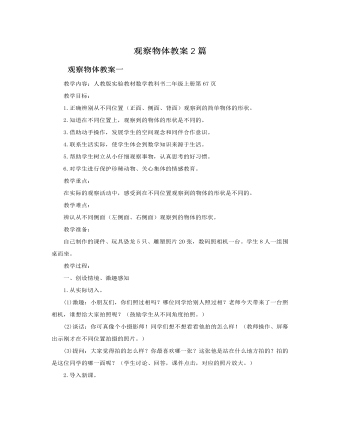
人教版新课标小学数学二年级上册观察物体教案2篇
教学过程:一、故事导入1.出示主题图配合音乐,师:“有一只蜻蜓在动物城里玩,遇到了辛勤工作的蜜蜂,看见了一座座漂亮的房屋。”蝴蝶说:“瞧。自己做了一件衣服,但是穿起来很不合身,怎么办?”(出现三种不对称的衣服图形)“于是,蝴蝶去找蜻蜓帮忙。”2.师:“一路上,蝴蝶看到许多美丽的景色,遇见许多动物朋友。瞧,美丽的孔雀走来了,还有知了、七星瓢虫、螃蟹。”3.师:“小朋友,它们美吗?你能说说你觉得它们哪儿美?(学生自由回答)那咱们把它们画下来,好吗?”二、初步感知对称图形的特点1.(指着蝴蝶形)师:“这么美的图形你想不想剪出一个来?请小朋友们拿出一张彩纸,用剪刀剪出这只蝴蝶,行吗?”(请学生说一说怎么剪的?)师:“有的小朋友剪出的蝴蝶为什么不像呢?为什么有的小朋友又能剪出美丽的蝴蝶呢?蝴蝶的形状到底有什么特点,让咱们来研究研究。”
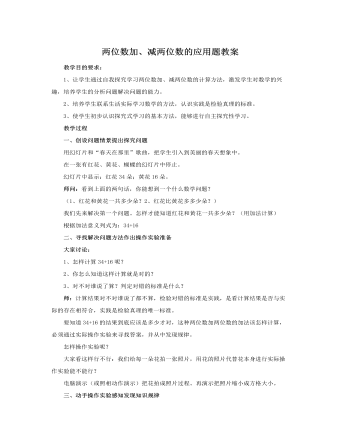
人教版新课标小学数学二年级上册两位数加、减两位数的应用题教案
1、试验性操作实验师:大家说红花的照片能不能用方格代表?下面请同学们用方格代表红花的照片,用我们的学具卡片摆出红花的朵数。(学生操作,教师巡视。)师:大家说黄花的朵数能不能也可以这样操作出?请同学们用上面的方法再操作出黄花的朵数。(学生操作)师:同学们已经摆出了红花的朵数和黄花的朵数,怎么操作才能知道红花和黄花一共是多少朵?(把红花的朵数和黄花的朵数合并起来数一数)(学生操作,教师巡视。)师:请把合并起来的数整理一下,让人一看就能知道是多少朵好吗?请同学们写出算式的答案。(即操作表达式)教师多媒体演示全部操作实验过程,并简单小结。2、验证性操作实验师:同学们,假如红花是56朵,黄花是38朵,求“红花和黄花共几朵?”你们还能不能用上面的操作实验方法来解决?(能)好!那就请你们试试看。(学生操作,教师巡视。)
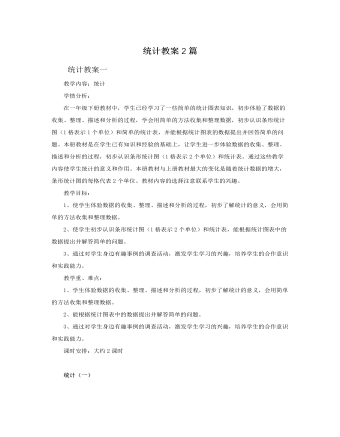
人教版新课标小学数学二年级上册统计教案2篇
1、让学生仔细观察,练习二十二1题图,你看到了什么?生:举手自由口答。2、师:根据这些信息,你能提出什么问题?板书学生提出问题在此基础上,师生重点解决问题3、小黑板出数统计表、统计图(1)学生在树上独立完成(2)上台展示并回答问题(3)师质疑:你还能提出哪些问题?[设计意图]:通过统计停车场每种车的数量,把解决问题和统计知识综合进来,巩固所学统计知识和解决问题,体验怎样收集信息。二、生活应用1、出示97页2题(1)同桌观察理解(2)独立在书上完成2、互相纠错评价,教师巡视辅导。3、质疑:你还能提出什么问题?[设计意图]:让学生通过数“正”字来收集信息。三、开放实践1、p97页3题4题(1)学生以小组为单位展开讨论统计。(1、2、3组做3题,4、5、6组做4题)(2)展示师生互评[设计意图]:让学生发挥主体性去调查收集数据,根据自己的能力提出并回答一些问题。
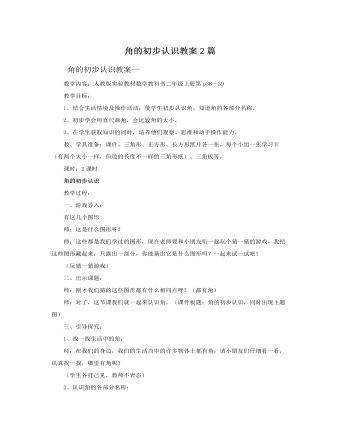
人教版新课标小学数学二年级上册角的初步认识教案2篇
【课中安排学唱《可爱的角》这首歌曲,旋律是学生熟悉并喜爱的,加上简明扼要的歌词和动作,提高了孩子们的兴趣。】四、课堂活动(课件出示)1.辨角。用你火眼金睛找出哪些是角?哪些不是角?为什么?(练习八的第1题)【在学生对角建立起概念的前提下,让学生做该练习,从而加深了学生对角的认识,增强分析、判断能力。这个练习可以叫它“跟随”练习,即刚学会一个新的概念,认识一个新的内容之后,紧跟着的一个比较容易的以选择和判断为主的练习。】2.数角(练习八的第2题)。师:小马看见小朋友们都认识了角,非常高兴,看看天色不早了,赶紧赶路,跑了一会儿,看见图形王国里面有许多图形,但小马不知道各有几个角?小朋友们能帮助它数一数吗?【这是一道“巩固”练习,让学生将所学知识做一次运用,难度稍加大,但学生能做出来,并且能找到练习中的规律,能享受到一种成就感。】
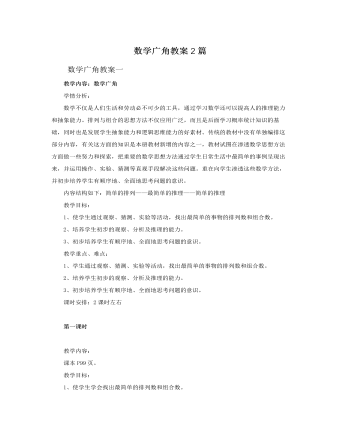
人教版新课标小学数学二年级上册数学广角教案2篇
方法三:我先把数字1放在个位,然后把数字2和3分别放在十位组成21和31;我再把数字2放在个位,然后把数字1和3分别放在十位组成12和32;我再把数字3放在个位,然后把数字1和2分别放在十位组成13和23,一共摆出了6个两位数。(21、31、12、32、13、23)每种方法说完后师问:还能摆吗?(再摆就要重复了!提示:不能遗漏也不能重复)师小结:排数的时候按照一定的顺序既不会重复也不会遗漏。我们用3个不同的一位数拼成了几个不同的两位数?(板书:6个)可拓展:三只动物抽到卡片后最多能组成21、31、32那谁可以和聪聪一起坐呀?小猫很幸运,他抽到了2和3,那么他一定会摆出一个……(三)握手小动物们谢谢我们帮他们一起解决了这些数学问题,一定要让老师表示谢意,好谢谢你们。(老师过去和学生握手。分别找几个人握手,让学生观察,每两个人握一次手。)
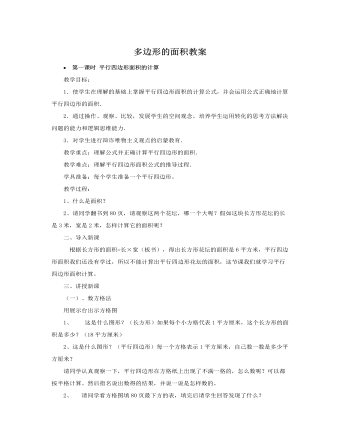
人教版新课标小学数学五年级上册多边形的面积教案
教学目标: 1.理解、掌握梯形面积的计算公式,并能运用公式正确计算梯形的面积。2.发展学生空间观念。培养抽象、概括和解决实际问题的能力。3.掌握“转化”的思想和方法,进一步明白事物之间是相互联系,可以转化的。教学重点:理解、掌握梯形面积的计算公式。教学难点:理解梯形面积公式的推导过程。教学过程:1.导入新课(1)投影出示一个三角形,提问:这是一个三角形,怎样求它的面积?三角形面积计算公式是怎样推导得到的?学生回答后,指名学生操作演示转化的方法。(2)展示台出示梯形,让学生说出它的上底、下底和各是多少厘米。(3)教师导语:我们已学会了用转化的方法推导三角形面积的计算公式,那怎样计算梯形的面积呢?这节课我们就来解决这个问题。(板书课题,梯形面积的计算)
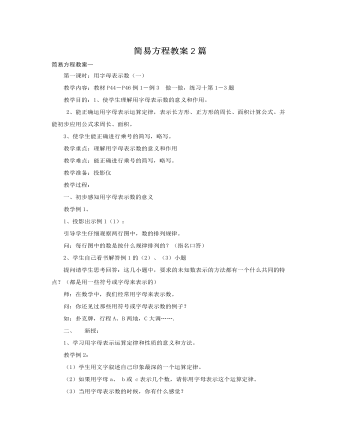
人教版新课标小学数学五年级上册简易方程教案2篇
(1) 你是用什么方法解方程的?要求学生独立完成。请一位同学在黑板上计算。学生交流:等式的两边同时加上同一个数,等式仍然成立。也就是方程 x-9=15的两边同时加上9,抵消掉等式左边的9,这样等式的左边只剩下x。(2) 你会检验方程的解是否正确吗?指导学生把方程的解代入方程进行检验。2.出示:64页第2题的第2小题。提问:你是根据哪个等量关系列出方程的?(1) 标准体重+超出标准的重量=胖胖的体重(2) 标准体重-低于标准的重量=小明的体重提问:他们标准体重的计算方法有什么不同?学生交流:一个是等式两边同时减去同一个数,一个是等式两边同时加上同一个数。三、拓宽应用。1.解方程:x-5.3=10 75-x=402.65页第4题提问:你是怎样选出各方程的解的?把未知数的值代入方程,看看左右是否相等。3.65页第5题提示学生认真读题,注意选择题中所给出的条件是否有用。
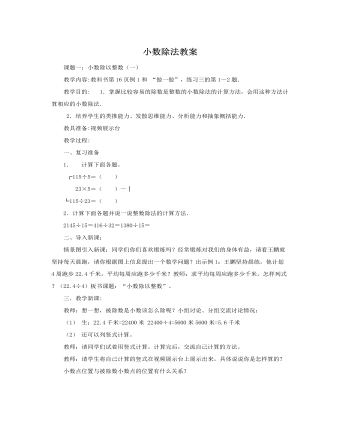
人教版新课标小学数学五年级上册小数除法教案
课题十: 解决问题(一)教学内容:解决问题教学目标:1、会解决有关小数除法的简单实际问题。2、能探索出解决问题的有效方法,并试图寻找其他方法,能表达解决问题的过程。教学过程:一、引入新课:前面我们学习了小数除法的计算,那么你会解决下面的问题吗?(板书课题)二、自主探索(出示例11)1、先独立思考解答。2、小组内交流,可以先算什么?3、小组汇报,全班交流,说说不同的思路。再指名说说。三、巩固练习1、“做一做”独立完成,全班交流。再指名说说不同的解题思路。2、完成P34 3师:你从此题中收集到了哪些信息?要解决什么问题?如何思考?生先独立思考,再小组交流,汇报分析过程。师小结,解答问题时要找准有直接关系的条件或信息。
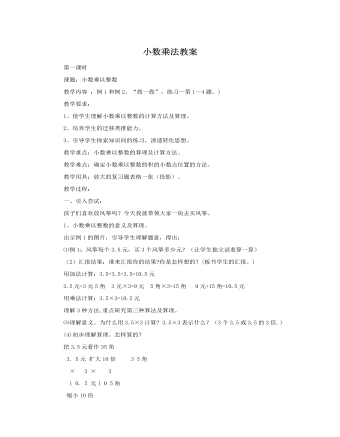
人教版新课标小学数学五年级上册小数乘法教案
教学内容:整数乘法运算定律推广到小数乘法 (P.12页例8和“做一做”,练习二第2题。)教学要求: 使学生理解整数乘法的运算定律对于小数同样适用,并会运用乘法的运算定律进行一些小数的简便计算。教学重点: 乘法运算定律中数(包括整数和小数)的适用范围。教学难点: 运用乘法的运算定律进行小数乘法的的简便运算。教学用具:投影片若干张。教学过程:一、激发:1、计算:25×95×4 25×32 4×48+6×48 102×562、在整数乘法中我们已学过哪些运算定律?请用字母表示出来。根据学生的回答,板书:乘法交换律 ab=ba乘法结合律 a(bc)=(ab)c乘法分配律 a(b+c)=ab+ac2、让学生举例说明怎样应用这些定律使计算简便。(注意学生举例时所用的数。)3、出示教材P.9页的3组算式:下面每组算式左右两边的结果相等吗?
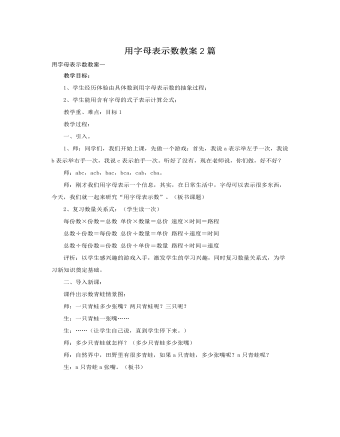
人教版新课标小学数学五年级上册用字母表示数教案2篇
教学目标:1、学生经历体验由具体数到用字母表示数的抽象过程;2、学生能用含有字母的式子表示计算公式;教学重、难点:目标1教学过程:一、引入。1、师:同学们,我们开始上课,先做一个游戏:首先,我说a表示举左手一次,我说b表示举右手一次,我说c表示拍手一次。听好了没有,现在老师说,你们做,好不好?师:abc,acb,bac,bca,cab,cba。师:刚才我们用字母表示一个信息,其实,在日常生活中,字母可以表示很多东西,今天,我们就一起来研究“用字母表示数”。(板书课题)2、复习数量关系式:(学生读一次)每份数×份数=总数 单价×数量=总价 速度×时间=路程总数÷份数=每份数 总价÷数量=单价 路程÷速度=时间总数÷每份数=份数 总价÷单价=数量 路程÷时间=速度评析:以学生感兴趣的游戏入手,激发学生的学习兴趣,同时复习数量关系式,为学习新知识奠定基础。
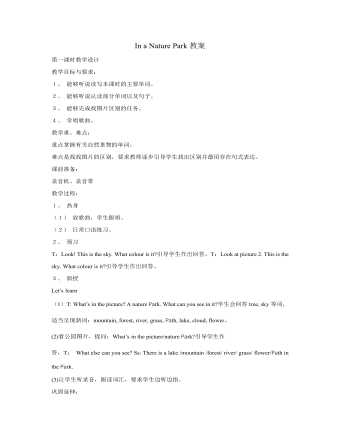
人教版新课标PEP小学英语五年级上册In a Nature Park教案
(3) 听录音,跟读。(4) 同桌之间,进行对话替换操练,然后先几组在班上说一说。(5) 听Let’s check.教师放录音。录音原文如下:Is there a lake in the nature Park?No, there is a river. The water is very clean.Are there any tall buildings in your village?No, there aren’t. There are only small houses.Is there a forest near your village? Yes, there is. There are many beautiful trees. Are there any bridges over the river? Yes, there are two bridges.巩固延伸:做配套练习;做“你猜我答”游戏;做Task time任务第六课时教学设计教学目标与要求:1、 能够听说读写本课句型及单词。2、 能用“There be…”句型介绍山村并描述其特征。教学重、难点:重点掌握句型的书写难点:单词的复数。课前准备:词卡、录音机、录音带教学过程:1、 热身(1) 日常口语练习。(2) 放录音,让学生跟着录音说唱。2、 预习做“拼单词”游戏。3、 新授Read and write(1) 看图,说:There are two pictures. What’s in the pictures? Listen.教师放录音,学生边听边阅读。(2) 学生就不懂的地方提问,教师解答。(3) 放录音,然后指导学生完成练习。(4) 指导学生书写四会句子。
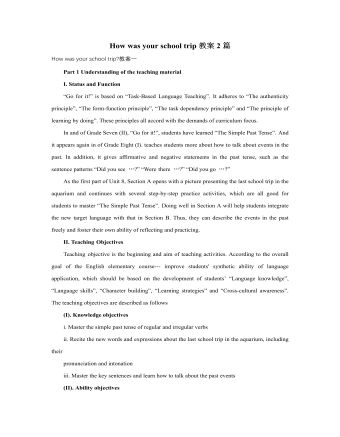
人教版新目标初中英语八年级上册How was your school trip教案2篇
“Go for it!” is based on “Task-Based Language Teaching”. It adheres to “The authenticity principle”, “The form-function principle”, “The task dependency principle” and “The principle of learning by doing”. These principles all accord with the demands of curriculum focus.In and of Grade Seven (II), “Go for it!”, students have learned “The Simple Past Tense”. And it appears again in of Grade Eight (I). teaches students more about how to talk about events in the past. In addition, it gives affirmative and negative statements in the past tense, such as the sentence patterns “Did you see …?” “Were there …?” “Did you go …?” As the first part of Unit 8, Section A opens with a picture presenting the last school trip in the aquarium and continues with several step-by-step practice activities, which are all good for students to master “The Simple Past Tense”. Doing well in Section A will help students integrate the new target language with that in Section B. Thus, they can describe the events in the past freely and foster their own ability of reflecting and practicing. II. Teaching ObjectivesTeaching objective is the beginning and aim of teaching activities. According to the overall goal of the English elementary course--- improve students' synthetic ability of language application, which should be based on the development of students’ “Language knowledge”, “Language skills”, “Character building”, “Learning strategies” and “Cross-cultural awareness”. The teaching objectives are described as follows(I). Knowledge objectivesi. Master the simple past tense of regular and irregular verbsii. Recite the new words and expressions about the last school trip in the aquarium, including their pronunciation and intonation

人教版新目标初中英语八年级上册How do you get to school教案2篇
Step Ⅶ Role play ( Work on 1b)1. First ask two students to read the dialogue to the class.Sa: How do you get to school?Sb: Well, I ride my bike to the subway station. Then I take the subway.2. Now work with a partner.Suppose you use two kinds of transportation to get to school \Hangzhou\Beijing... (bus, train, subway, walking, bike, etc.) Tell how you get there. You may use the phrases in 1a.3. Then ask different pairs of students to present their conversations to the class.Step ⅧListening1. Work on 2a(1) First ask students to read the list of information that Thomas wants to know.…where Nina lives.…how far from school she lives.…how long it takes to get to school.…how she gets to school.…what she thinks of the transportation.(2) Tell students what transportation and bus stop mean.bus stop 汽车站 transportation n. 运送;运输Then tell students we'll hear a recording. Please put a checkmark in front of each thing that Thomas wants to know.(3) Now play the recording for students.( Have students pay attention to the sample answer.) (4) Then correct the answers.

人教版新目标初中英语八年级上册I’m going to be a basketball player教案3篇
教学目标1.知识目标:(1)学习What are you going to be when you grow up?/How are you going to do that?句式。(2)学会用英语描述有关职业的表达法。2.能力目标:(1)能够谈论为实现理想所做出的打算和安排。(2)能够谈论未来自己与他人理想的职业及原因。(3)能用英语描述课余时间的活动安排,最终具备表达综合信息的能力。3.情感目标:新学期到来之际,让他们在学习、体育、饮食、特长、读书等方面制定计划,教育学生合理安排自己的课外生活,思考自己的理想职业及适合自己的职业。教学重点、难点本单元的重点为“be going to”表将来,want to be, what,where, when,how引导的特殊疑问句。难点是语言目标的实现。教材分析本单元以I am going to be a basketball player为话题,共设计了三部分的内容:一、Section A该部分有4个模块。第一模块围绕Do you think these jobs are interesting?这一话题展开思维(1a)、听力(1b)、口语(1c)训练;
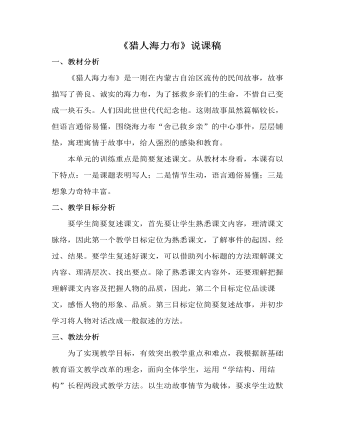
部编人教版五年级上册《猎人海力布》说课稿
一、教材分析《猎人海力布》是一则在内蒙古自治区流传的民间故事,故事描写了善良、诚实的海力布,为了拯救乡亲们的生命,不惜自己变成一块石头。人们因此世世代代纪念他。这则故事虽然篇幅较长,但语言通俗易懂,围绕海力布“舍己救乡亲”的中心事件,层层铺垫,寓理寓情于故事中,给人强烈的感染和教育。本单元的训练重点是简要复述课文。从教材本身看,本课有以下特点:一是课题表明写人;二是情节生动,语言通俗易懂;三是想象力奇特丰富。二、教学目标分析要学生简要复述课文,首先要让学生熟悉课文内容,理清课文脉络,因此第一个教学目标定位为熟悉课文,了解事件的起因、经过、结果。要学生复述好课文,可以借助列小标题的方法理解课文内容、理清层次、找出要点。除了熟悉课文内容外,还要理解把握理解课文内容及把握人物的品质,因此,第二个目标定位品读课文,感悟人物的形象、品质。第三目标定位简要复述故事,并初步学习将人物对话改成一般叙述的方法。
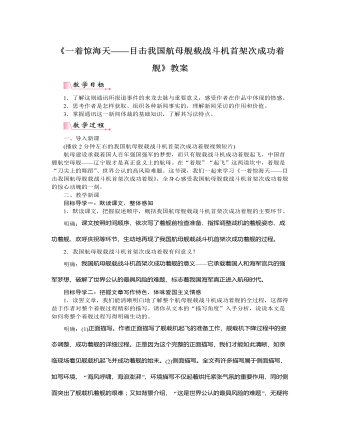
部编版语文八年级上册《一着惊海天——目击我国航母舰载战斗机首架次成功着舰》教案
2.为了表现出我国航母舰载战斗机首架次成功着舰时惊心动魄的气势,表现出舰载机成功着舰后国人的喜悦,作者在语言上也下了一番功夫,请你结合课文做具体分析。明确:(1)运用修辞手法,描绘着舰场面。“声如千骑疾,气卷万山来。”运用对偶、夸张和比喻的修辞手法,增强文章气势,生动形象地表现了舰载机着舰时的浩大声势,具有感染力。(2)运用细节描写,生动形象地描绘出舰载机着舰的情形。如“震耳欲聋”“轰鸣”描绘出舰载机着舰时巨大的声音,“眨眼之间”“刹那间”“疾如闪电”等词描绘出舰载机着舰时的震撼场面。“牢牢地”“稳稳地”生动地写出了我国舰载机着舰技术的成熟和飞行员操作技能的娴熟。“定格了一个象征胜利的巨大‘V’字”的特写镜头,既是对当时情景的生动再现,也表现了作者对我国航母舰载战斗机首架次成功着舰的喜悦和自豪。
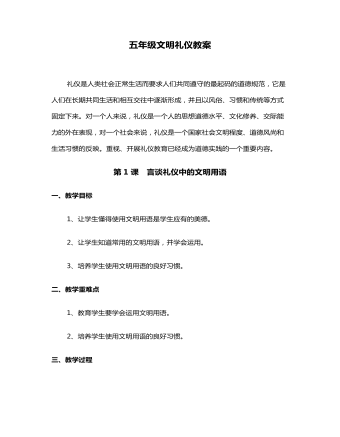
五年级礼仪课教学教材教案
一、教学目标1、让学生懂得使用文明用语是学生应有的美德。2、让学生知道常用的文明用语,并学会运用。3、培养学生使用文明用语的良好习惯。
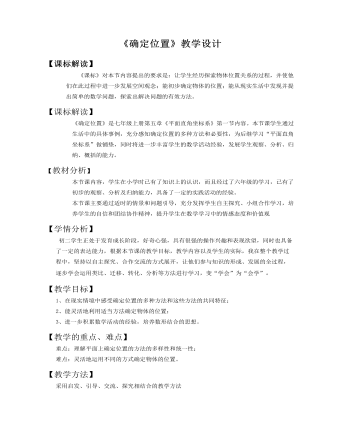
初中数学鲁教版七年级上册《第五章 位置与坐标 1 确定位置》教学设计教案
1、通过同位之间互说座位位置,检测知识目标2、3的达成效果。2、通过导学案上的探究一,检测知识目标2、3的达成效果。 3、通过探究二,检测知识目标1、3的达成效果。 4、通过课堂反馈,检测总体教学目标的达成效果。本节课遵循分层施教的原则,以适应不同学生的发展与提高,针对学生回答问题本着多鼓励、少批评的原则,具体从以下几方面进行评价:1、通过学生独立思考、参与小组交流和班级集体展示,教师课堂观察学生的表现,了解学生对知识的理解和掌握情况。教师进行适时的反应评价,同时促进学生的自评与互评。2、通过设计课堂互说座位、探究一、二及达标检测题,检测学习目标达成情况,同时有利于学生完成对自己的评价。3.通过课后作业,了解学生对本课时知识的掌握情况,同时又能检测学生分析解决问题的方法和思路,完成教学反馈评价。
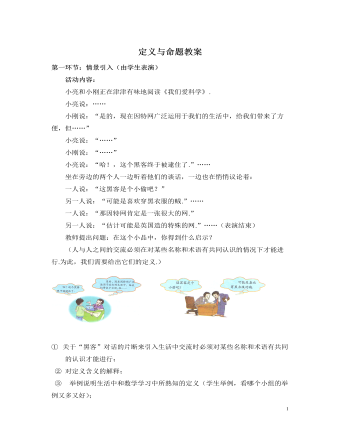
北师大初中数学八年级上册定义与命题2教案
② 命题的含义:判断一件事情的句子,叫做命题,如果一个句子没有对某一件事情作出任何判断,那么它就不是命题.活动目的:通过课后的总结,使学生对定义、命题等概念有更清楚的认识,让学生在头脑中对本节课进行系统的归纳与整理.教学效果:学生在有了前面对定义、特别是命题概念的学习后,能了解命题的结构,以及哪些是命题,使学生对命题的学习有了清楚的认识。第五环节 课后练习学习小组搜集八年级数学课本中的新学的部分定义、命题,看谁找得多.四、教学反思本节课的设计具有如下特点:(1)采用了“小品表演”的形式引入新课,意在激起学生对数学的兴趣,让学生知道,数学不是枯燥无味的。并能从表演中不同的人对“黑客”这个名词的不同理解更好地悟出“定义”的含义。
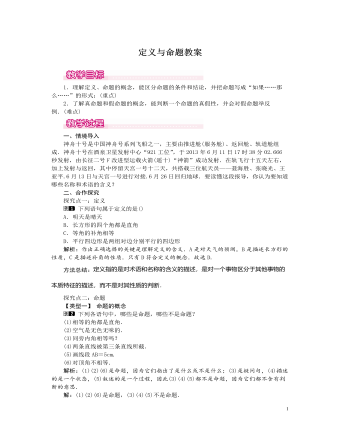
北师大初中数学八年级上册定义与命题1教案
一、情境导入神舟十号是中国神舟号系列飞船之一,主要由推进舱(服务舱)、返回舱、轨道舱组成.神舟十号在酒泉卫星发射中心“921工位”,于2013年6月11日17时38分02.666秒发射,由长征二号F改进型运载火箭(遥十)“神箭”成功发射.在轨飞行十五天左右,加上发射与返回,其中停留天宫一号十二天,共搭载三位航天员——聂海胜、张晓光、王亚平.6月13日与天宫一号进行对接.6月26日回归地球.要读懂这段报导,你认为要知道哪些名称和术语的含义?二、合作探究探究点一:定义 下列语句属于定义的是()A.明天是晴天B.长方形的四个角都是直角C.等角的补角相等D.平行四边形是两组对边分别平行的四边形解析:作出正确选择的关键是理解定义的含义.A是对天气的预测,B是描述长方形的性质,C是描述补角的性质.只有D符合定义的概念.故选D.方法总结:定义指的是对术语和名称的含义的描述,是对一个事物区分于其他事物的本质特征的描述,而不是对其性质的判断.